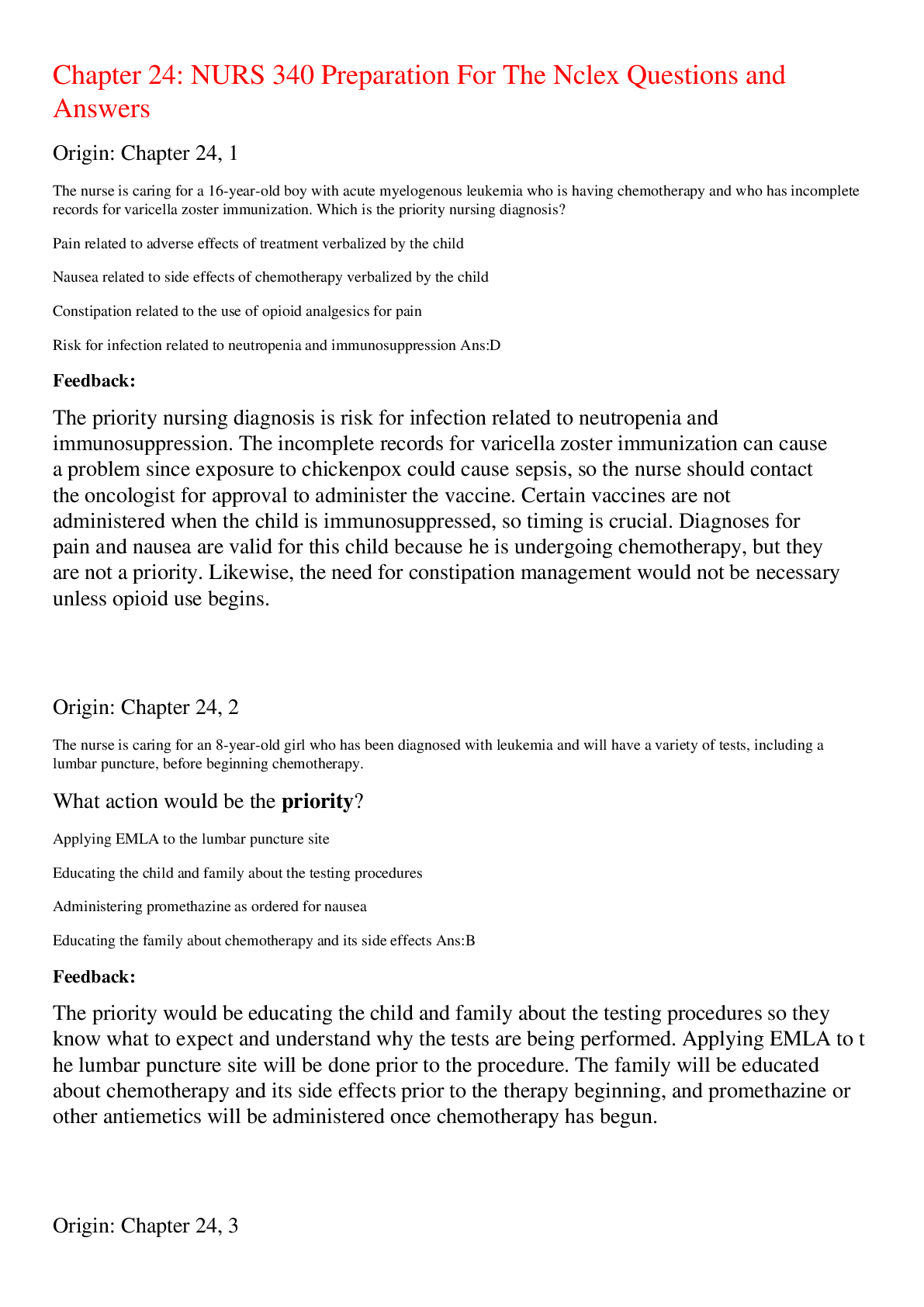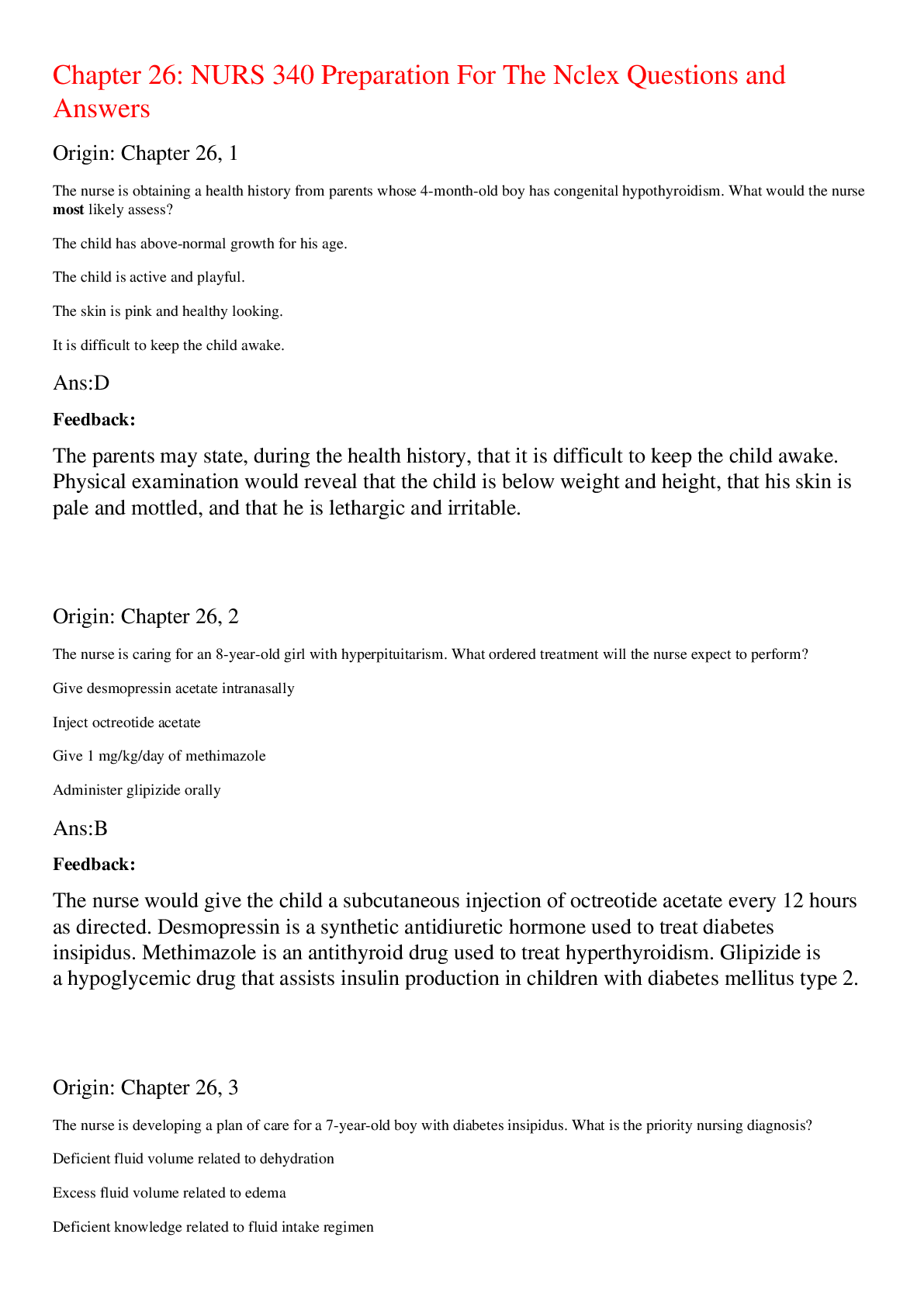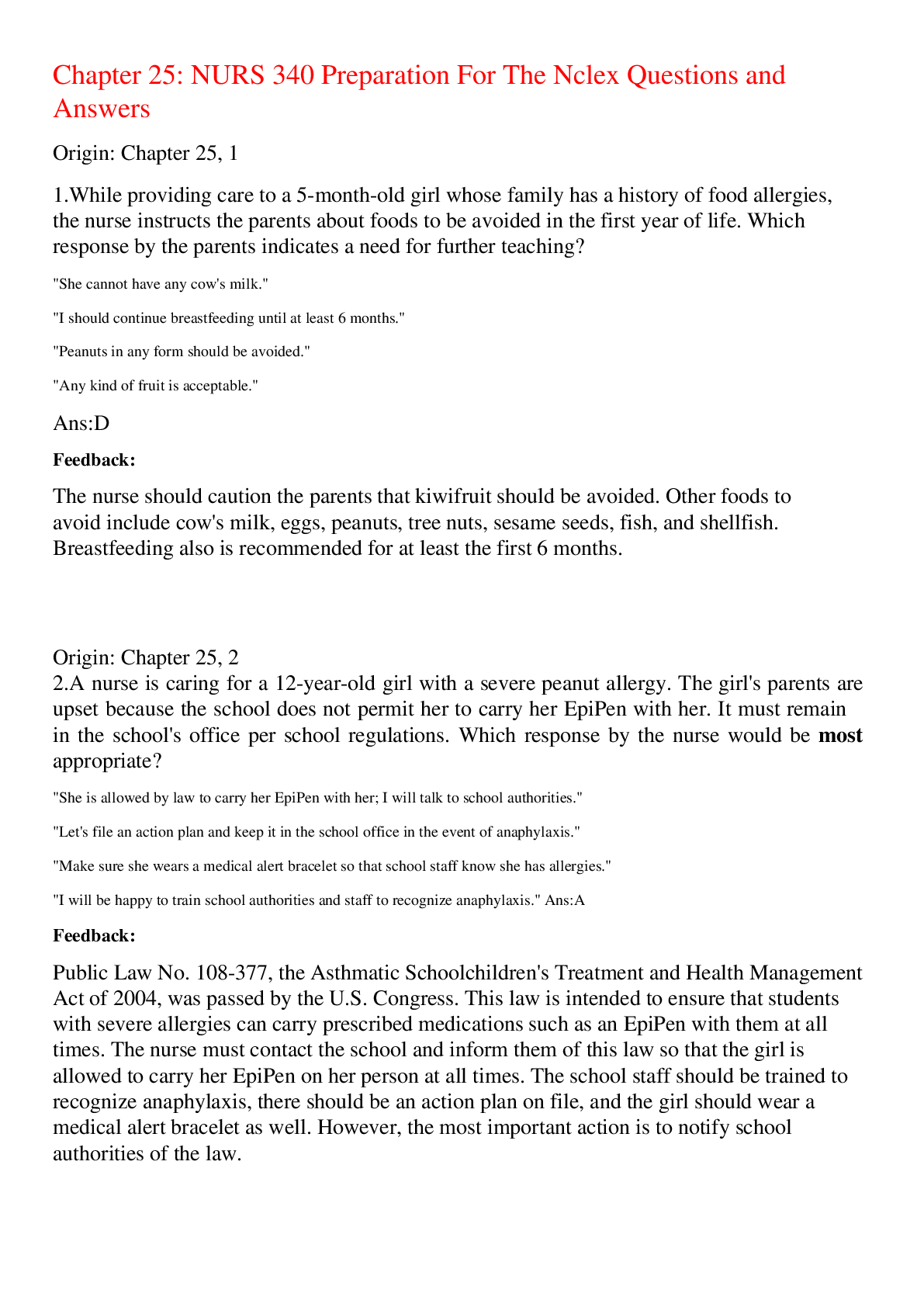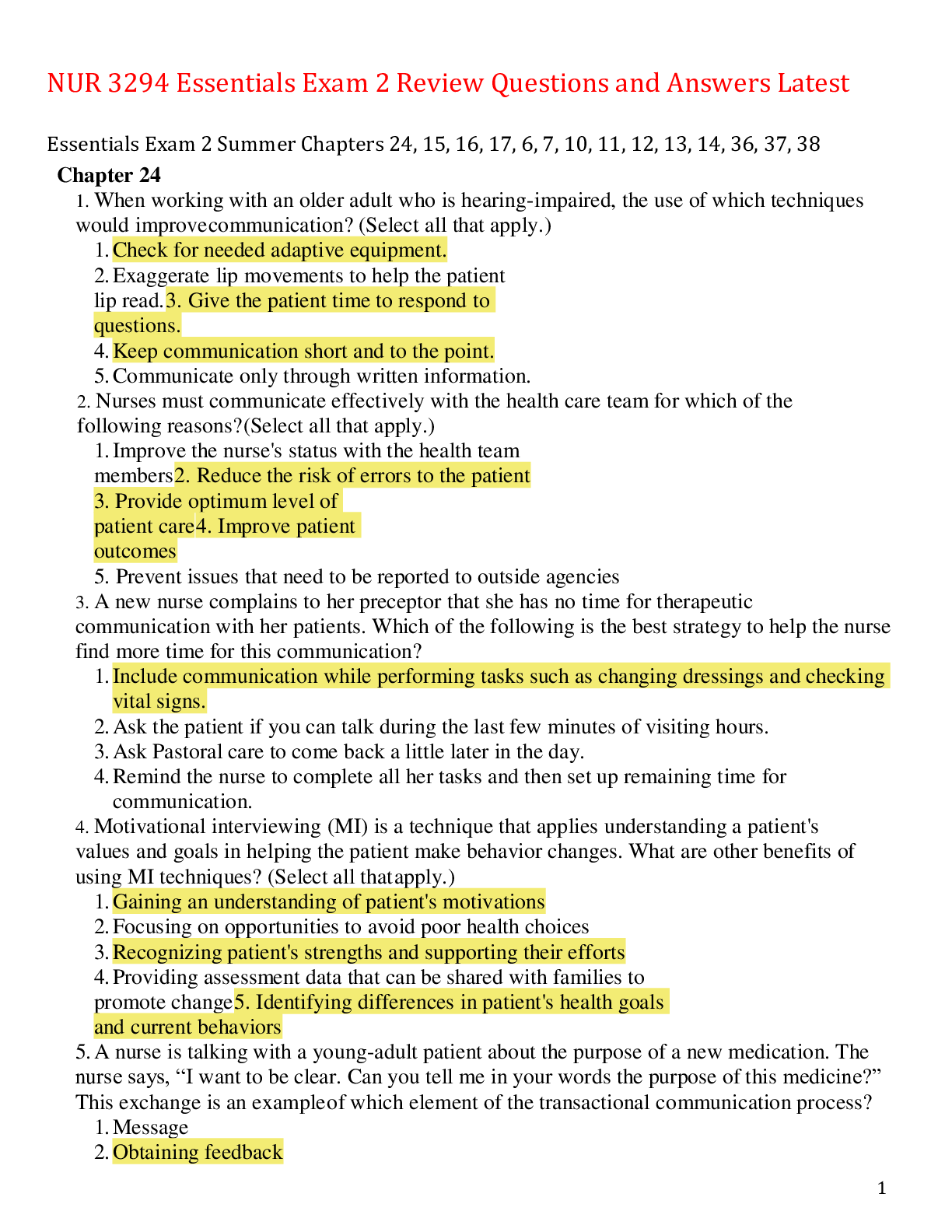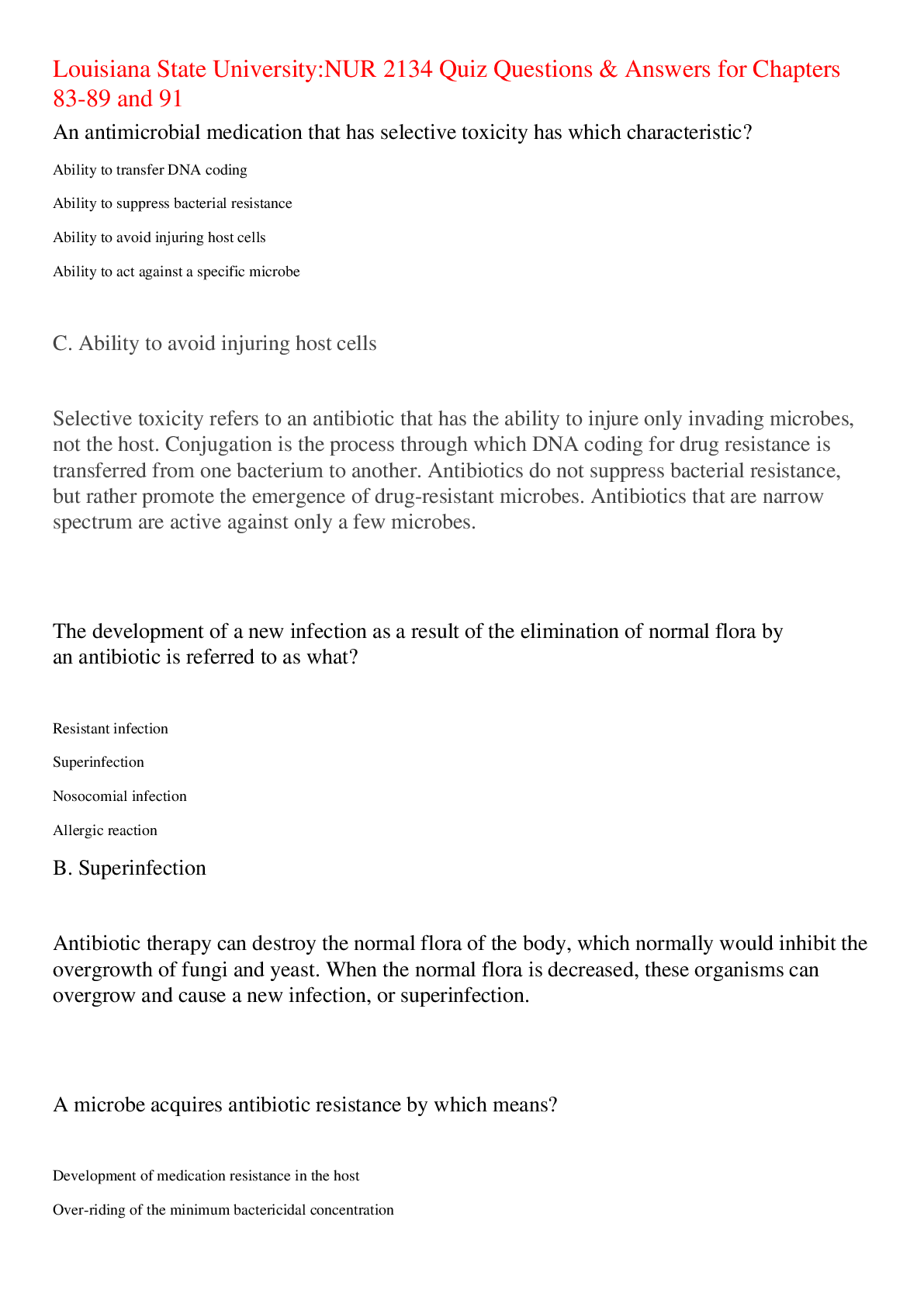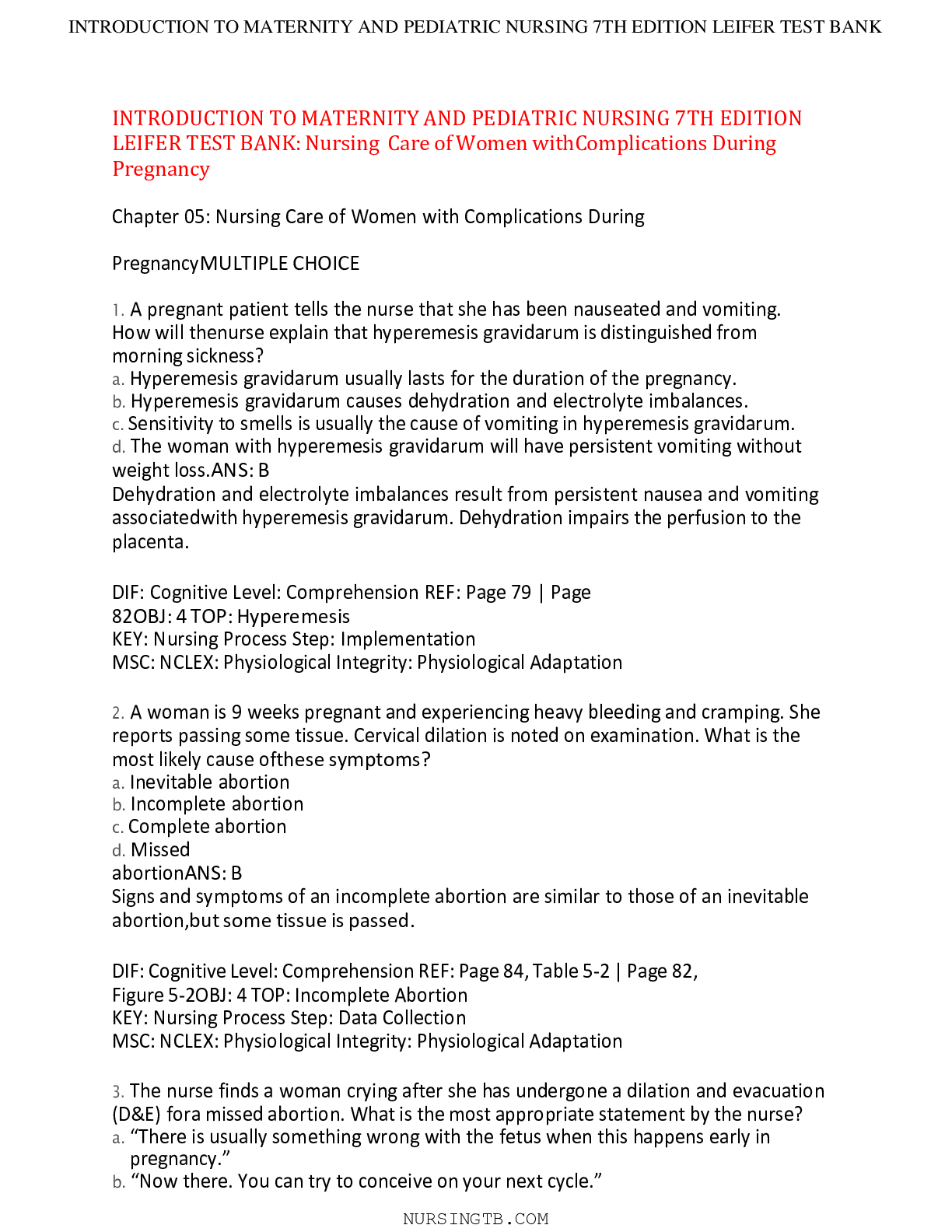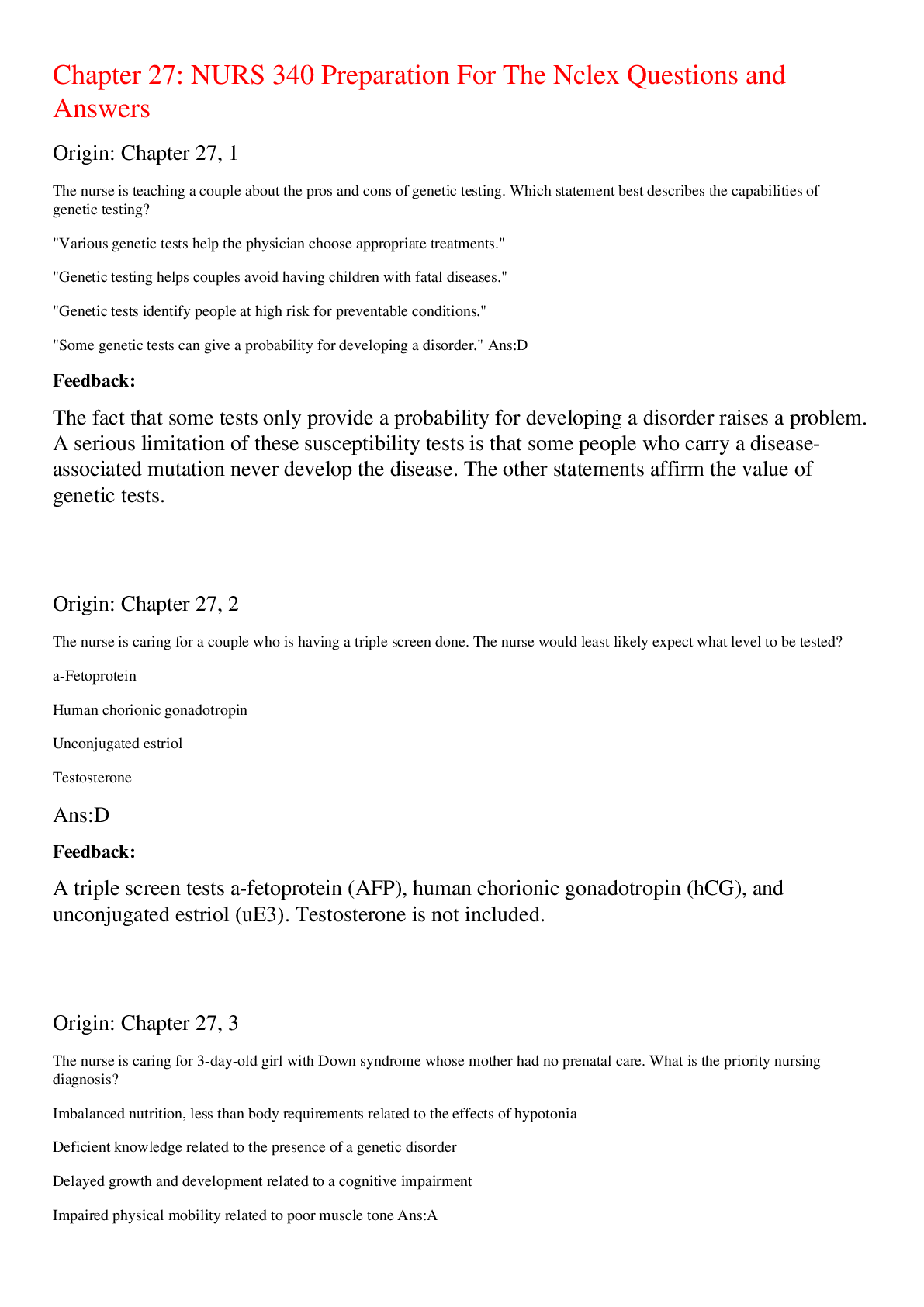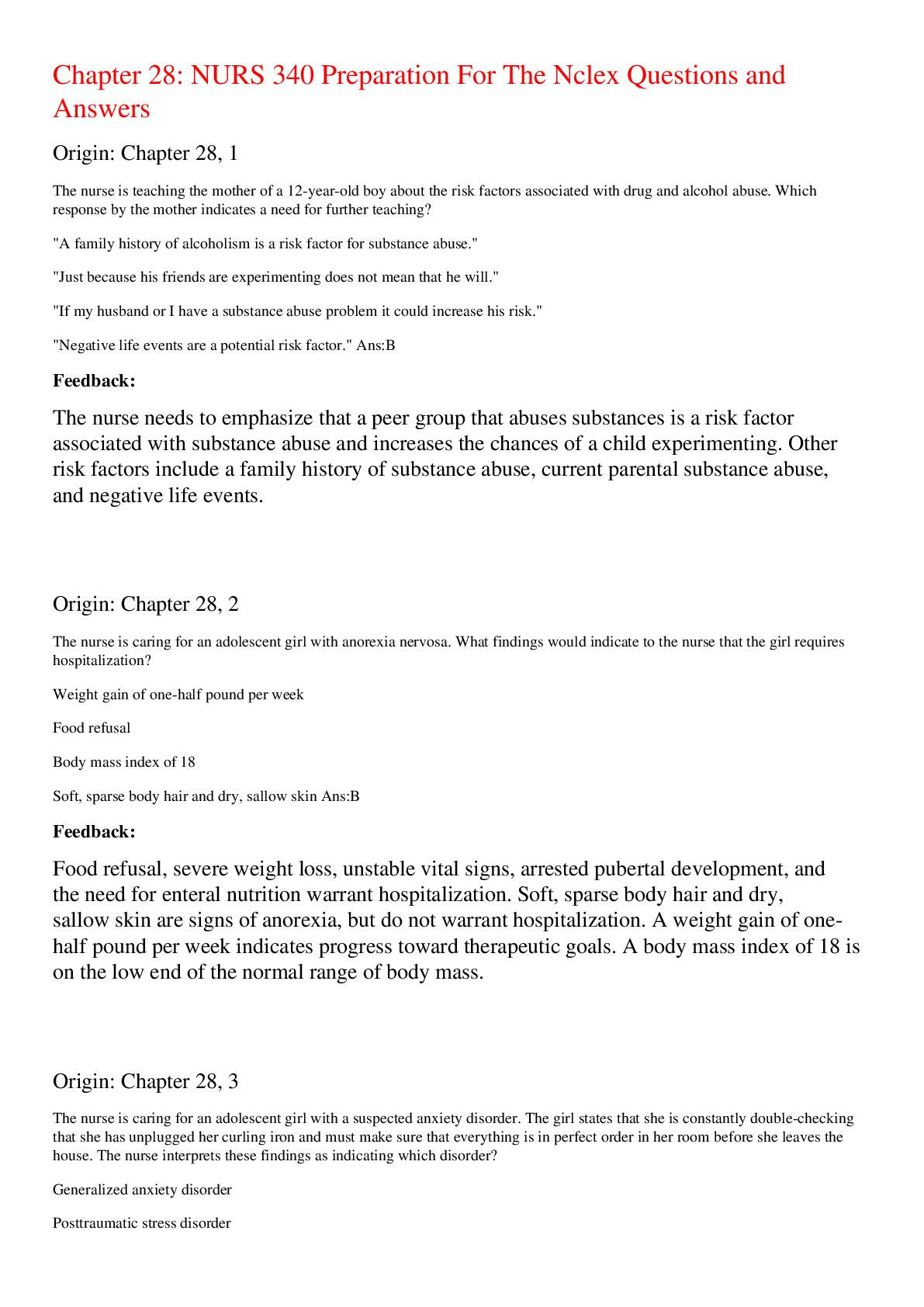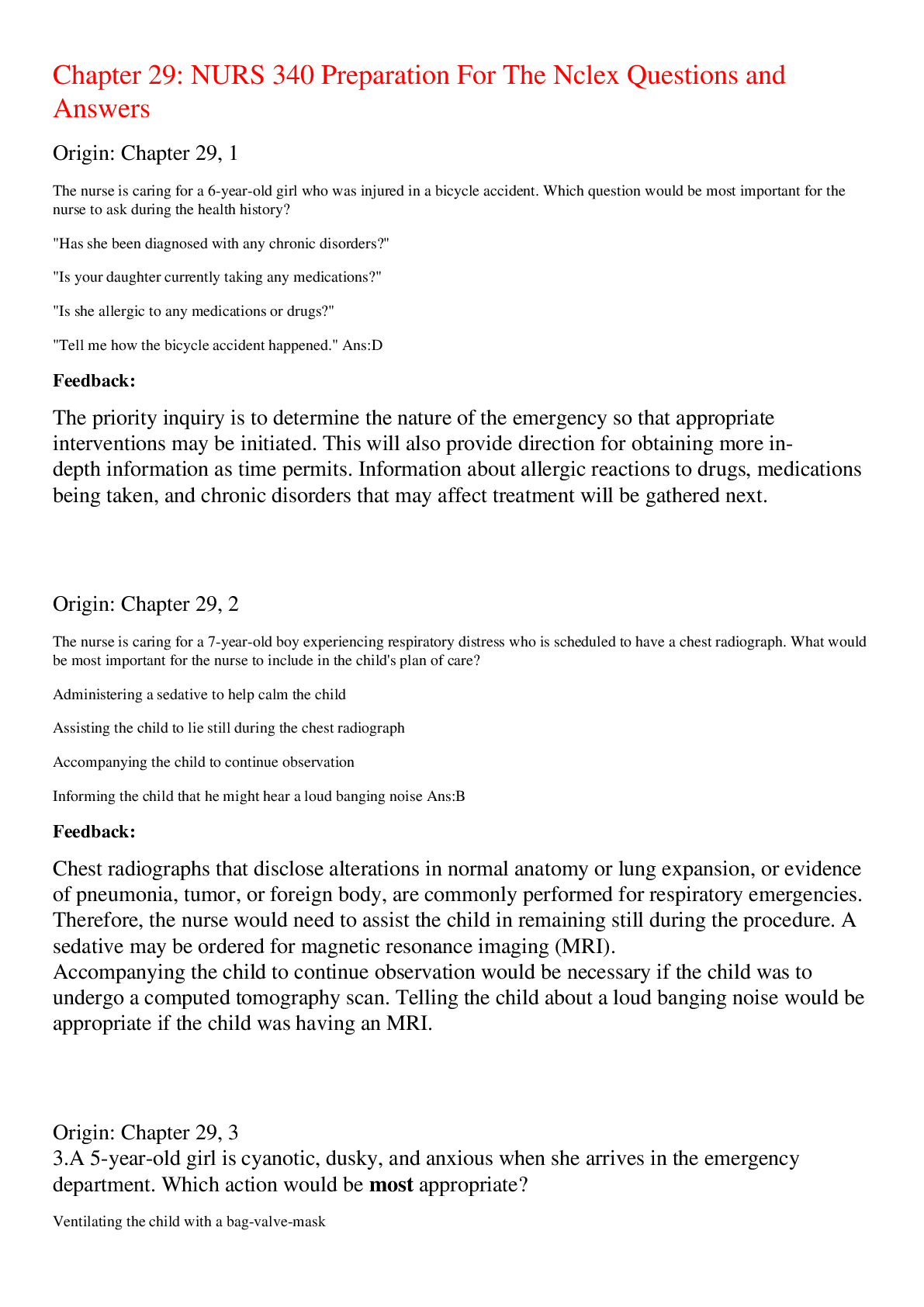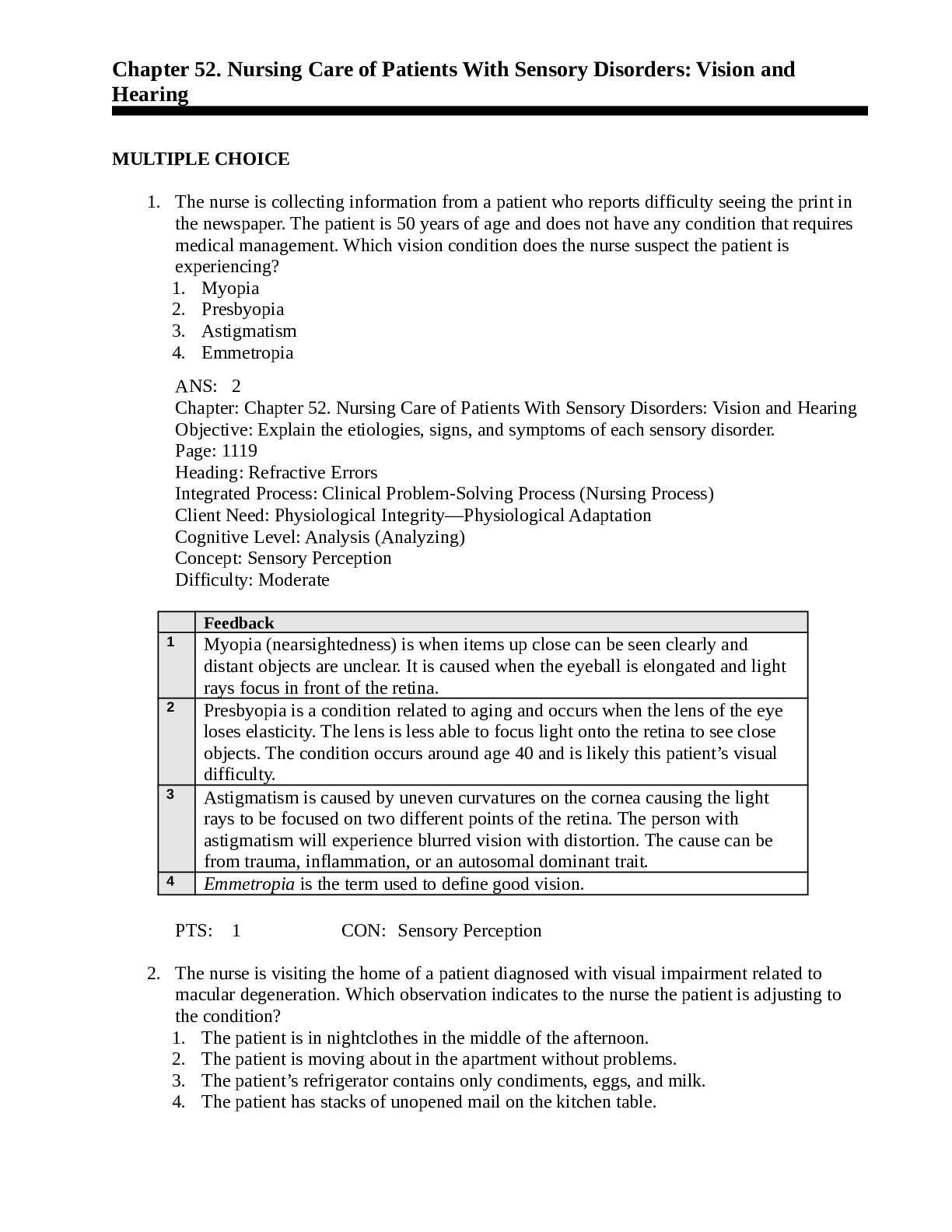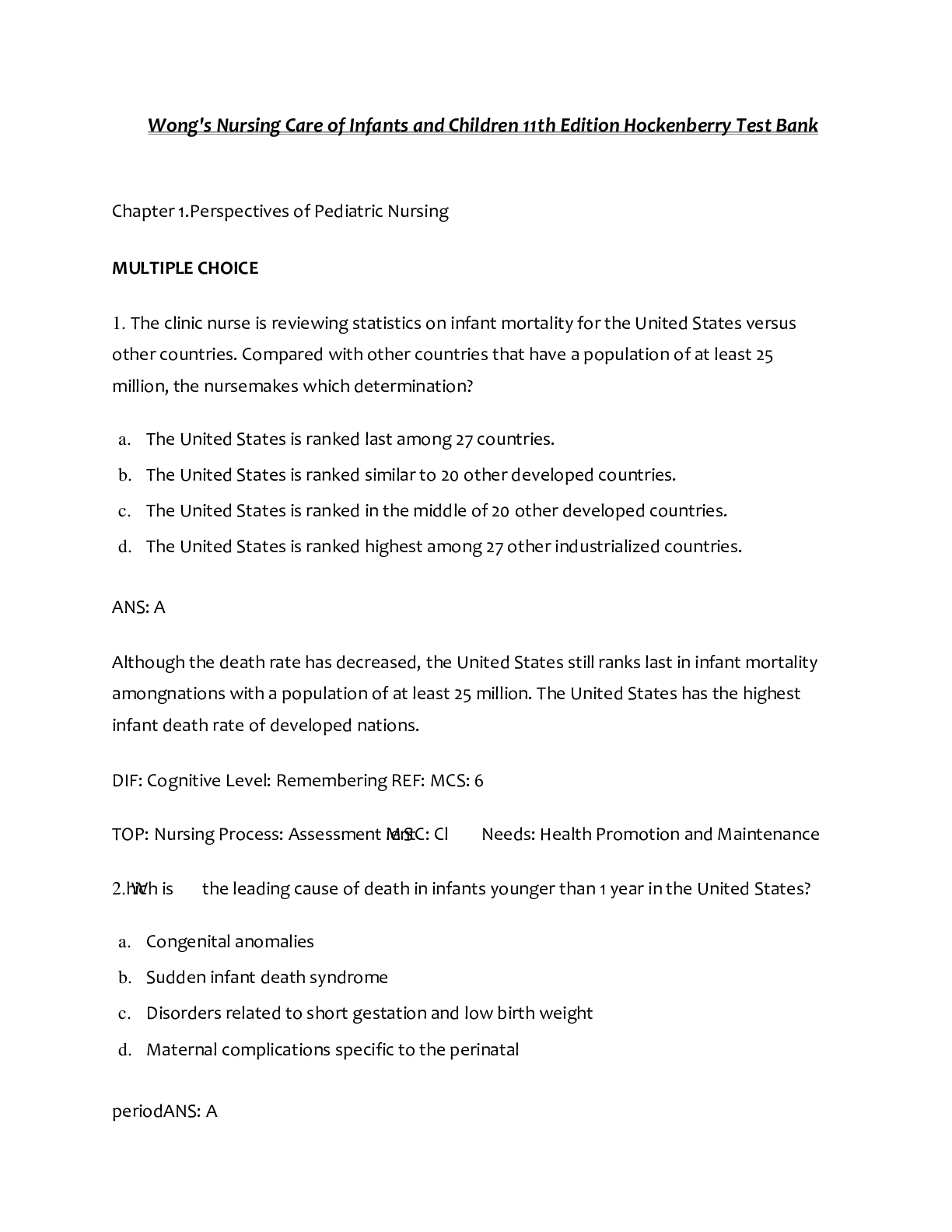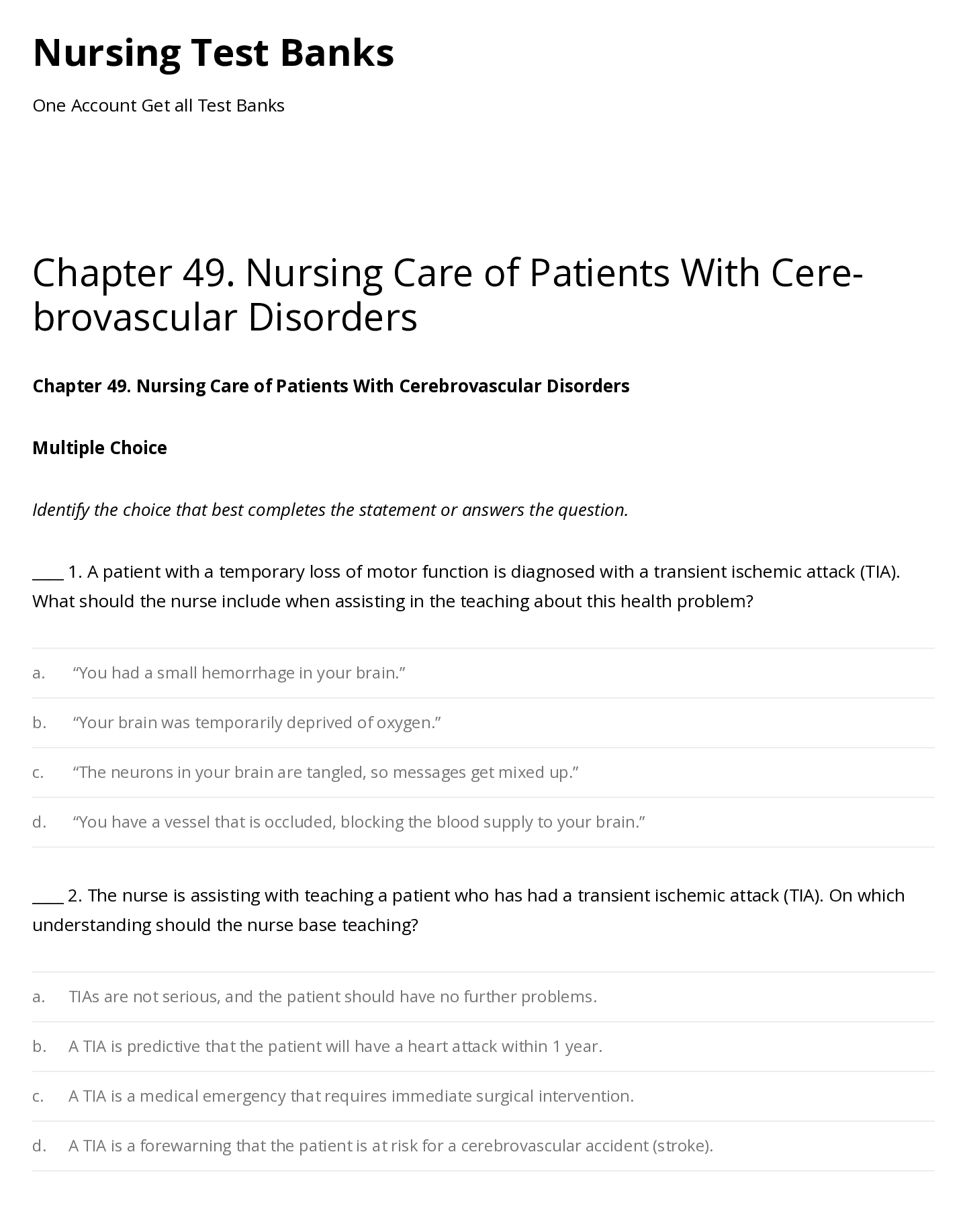*NURSING > TEST BANKS > NR 226/ATI Nursing Care of Children 2 Questions and Answers,100% CORRECT (All)
NR 226/ATI Nursing Care of Children 2 Questions and Answers,100% CORRECT
Document Content and Description Below
NR 226/ATI Nursing Care of Children 2 Questions and Answers 1) A nurse in an emergency department is caring for a 4-year-old child who has burns to the neck and face following a house fire. Which o... f the following actions should the nurse take first? A. Cover the child's wounds with a clean, dry cloth. The nurse should cover the child’s wounds with a clean, dry cloth; however, there is a different action the nurse should take first. B. Establish IV access for the child with a large-bore catheter. The nurse should establish IV access for the child using a large-bore catheter; however, there is a different action the nurse should take first. C. Provide reassurance to the child's parents. The nurse should provide reassurance to the child’s parents; however, there is a different action the nurse should take first. D. Determine the child's breathing pattern. The nurse should apply the ABC priority setting framework. This framework emphasizes the basic core of human functioning: having an open airway, being able to breathe in adequate amounts of oxygen, and circulating oxygen to the body's organs via the blood. An alteration in any of these can indicate a threat to life, and is therefore the nurse’s priority concern. When applying the ABC priority setting framework, airway is always the highest priority because the airway must be clear and open for oxygen exchange to occur. Breathing is the second highest priority in the ABC priority setting framework because adequate ventilatory effort is essential in order for oxygen exchange to occur. Determining the child’s breathing pattern is the first action the nurse should take. Circulation is the third highest priority in the ABC priority setting framework because delivery of oxygen to critical organs only occurs if the heart and blood vessels are capable of efficiently carrying oxygen to them. 2) A nurse is providing teaching to the parent of a 2-year-old toddler about nutrition. Which of the following statements by the parent indicates an understanding of the teaching? A. "My child should consume 1,000 calories per day." Toddlers who are 2 years old should consume 1,000 calories daily. B. "My child should have 4 ounces of protein per day." Toddlers who are 2 years old should have 2 oz of protein daily. C. "I should give my child 32 ounces (4 cups) of milk per day." Toddlers who are 2 years old should have no more than 24 oz (3 cups) of milk per day. D. "I should feed my child 4 ounces (1/2 cup) of vegetables per day." Toddlers who are 2 years old should consume 8 oz (1 cup) of vegetables per day. 3) A nurse is providing discharge teaching to the parent of a school-age child who has leukemia and is receiving chemotherapy. Which of the following statements by the parent indicates an understanding of the teaching? A. "I will take my child's rectal temperature daily." The parent should avoid taking rectal temperatures to prevent trauma to the child. B. "I will make sure my child gets his MMR vaccine this week." A child who has leukemia will have a compromised immune system and should not receive the MMR vaccine. C. "I will inspect my child's mouth every day for sores." A child who has leukemia is at an increased risk for mucositis; therefore, the parent should inspect the child’s mouth daily for lesions or ulcerations. D. "I will allow my child to ride his bicycle tomorrow." The nurse should advise the parents to avoid any activities that could cause injury or bleeding, such as riding bicycles or climbing on playground equipment. 4) A nurse is preparing to obtain an antistreptolysin O (ASO) titer from a child who has acute glomerulonephritis. The child's parent asks the nurse to explain the purpose of the test. Which of the following responses should the nurse make? A. "The test determines the level of antibiotics in your child's blood." A therapeutic blood level indicates a medication, such as an antibiotic, is effective. B. "The test tells us if your child ever had the measles." A rubella titer will indicate the presence of measles. C. "The test verifies the amount of albumin in your child's blood." A serum albumin level is monitored in a child who has nephrotic syndrome. D. "The test shows us if your child had a recent strep infection." An ASO titer indicates that the child has had a recent strep infection. In determining a definitive diagnosis for acute glomerulonephritis, this must be documented as it is usually the result of this type of infection. 5) A nurse is providing nutritional teaching to an adolescent client who has celiac disease. Which of the following breakfast foods should the nurse recommend? A. Plain flour pastry The client who has celiac disease should be on a low-gluten diet. Gluten is found primarily in wheat and rye, but also is found in smaller quantities in barley and oats; therefore, plain flour pastries are an inappropriate breakfast item for the nurse to recommend to the client. B. Wheat cereal The client who has celiac disease should be on a low-gluten diet. Gluten is found primarily in wheat and rye, but also is found in smaller quantities in barley and oats; therefore, wheat cereal is an inappropriate breakfast item for the nurse to recommend to the client. C. Scrambled eggs The client who has celiac disease should be on a low-gluten diet and should avoid foods containing barley, oat, rye, and wheat; therefore, scrambled eggs are an appropriate breakfast item for the nurse to recommend to the client. D. Rye toast The client who has celiac disease should be on a low-gluten diet. Gluten is found primarily in wheat and rye; therefore, rye toast is an inappropriate breakfast item for the nurse to recommend to the client. 6) A nurse is providing teaching to an adolescent who has scoliosis and a new prescription for a Boston brace. Which of the following responses by the adolescent indicates an understanding of the teaching? A. "I can take my brace off to sleep every night at bedtime." The child should wear the brace for 23 hr each day. At night, the child might be prescribed a bending brace that confines the spine to an over-corrected positon. B. "I can take my brace off for about an hour daily to shower." The nurse should instruct the child to wear the brace for 23 hr each day and to only remove it for showering or participating in physical therapy. C. "I should loosen the straps on my brace if it is rubbing my skin." The nurse should instruct the adolescent to avoid loosening the straps of the brace if rubbing occurs because this can decrease compression and contraction. D. "I should place the pads of brace against my skin with a t-shirt over them." The brace should be worn over a t-shirt to prevent the plastic pads from touching the skin and causing excoriation. 7) A nurse is assessing a toddler who has measles (rubeola). Which of the following findings should the nurse expect? A. Koplik spots Koplik spots are small, irregular oral lesions with a bluish-white center and are characteristic of measles (rubeola). Koplik spots appear about 2 days before the maculopapular rash appears and are accompanied by manifestations of fever, malaise, conjunctivitis, and other cold manifestations. B. Parotitis Swollen parotid glands are an expected finding in a child who has mumps. C. Strawberry tongue Strawberry tongue is an expected finding in a child who has scarlet fever. D. Paroxysmal cough Paroxysmal cough is an expected finding in a child who has pertussis. 8) A nurse is providing dietary teaching to the parent of a child who has cystic fibrosis. Which of the following dietary recommendations should the nurse make? A. Increase the child's protein intake. The nurse should recommend an increase in protein intake for the child who has cystic fibrosis. These children require up to 150% of the recommended daily allowances to meet their nutritional needs. B. Decrease the child's calorie intake. The calorie intake for a child who has cystic fibrosis should be increased, rather than decreased. C. Increase the child's fiber intake. Increasing fiber intake could increase bulk and malabsorption might occur; therefore, it is not indicated for this child. D. Decrease the child's salt intake. Decreasing salt intake is not indicated for the child who has cystic fibrosis. 9) A nurse is admitting a child who has Wilms' tumor. Which of the following actions should the nurse take? A. Initiate contact precautions for the child. Contact precautions are indicated for children who are suspected to have illnesses transmitted by client contact or contact with items in the client’s environment. B. Explain to the parents that chemotherapy will start 3 months following surgery. Radiology and chemotherapy are begun immediately following surgery. C. Put a "no abdominal palpation" sign over the child's bed. The nurse should place a sign over the child’s bed reading "no abdominal palpation" because palpation is not necessary to confirm diagnosis and could aid in metastasis. D. Prepare the child for a spinal tap. A spinal tap is a diagnostic test which provides samples of spinal fluid to confirm infection or abnormal cells. 10) A nurse is caring for an infant following surgical repair of a cleft lip and palate. Which of the following actions should the nurse take? A. Keep the infant's mouth open by using a tongue blade for 4 hr following surgery. The nurse should avoid placing objects in the infant’s mouth during the postoperative period to avoid trauma to the incision. B. Suction the infant gently with a bulb syringe PRN. The nurse should gently suction the infant’s mouth with a bulb syringe to maintain a patent airway. C. Place the infant in prone position. The nurse should position the infant upright to facilitate drainage of secretions. Placing the infant in prone position could lead to aspiration. D. Clean the infant's incision with chlorhexidine. The nurse should clean the operative incision with sterile saline or sterile water after each feeding and as needed. 11) A clinic nurse is providing teaching to the parent of a 1-month-old infant who has gastroesophageal reflux. Which of the following statements by the parent indicates an understanding of the teaching? A. "I will give the lansoprazole 30 min after my baby's feedings." The mother should give the medication to her infant 30 min before feeding because it is most effective during mealtime when the infant’s plasma concentration is at its peak. B. "I will lay my baby on her side after feedings." The infant should be placed in an infant seat or at a 30° angle for 1 hr after feedings. C. "I will give my baby a bottle just before bedtime." The nurse should instruct the parent to avoid feedings just before bedtime. D. "I will add rice cereal to my baby's feedings." The mother should add 1 tsp to 1 tbsp of rice cereal per ounce of formula or expressed breast milk to thicken the feedings because this will decrease the number of vomiting episodes. 12) A nurse is teaching about clinical manifestations of tracheomalacia to a parent of an infant who had tracheoesophageal fistula repair as a newborn. Which of the following findings should the nurse include in the teaching? A. Absence of bowel sounds Tracheoesophageal fistula is an upper gastrointestinal disorder; therefore, bowel sounds would not be absent in this condition. B. Neck contortions Neck contortions are an expected finding in an infant who has a hiatal hernia. C. Barking cough Infants who have tracheomalacia have a weakened trachea, which leads to collapse. Clinical manifestations of tracheomalacia include barking cough, stridor, wheezing cyanosis, and apnea. D. Projectile vomiting Projectile vomiting is an expected finding in an infant who has hypertrophic pyloric stenosis. 13) A nurse in an emergency department is assessing a school-age child who is experiencing an acute asthma exacerbation. Which of the following findings is the priority for the nurse to report to the provider? A. Excessively prolonged expiration The nurse should report excessively prolonged expiration to the provider; however, there is a different finding the nurse should report first. B. Increased diaphoresis The nurse should report increased diaphoresis to the provider; however, there is a different finding the nurse should report first. C. Increased production of frothy sputum The nurse should report an increased production of frothy sputum to the provider; however, there is a different finding the nurse should report first. D. Sudden decrease in wheezing The nurse should apply the urgent versus nonurgent priority setting framework. Using this framework, the nurse should consider urgent needs the priority need because they pose a larger risk to the client. A sudden decrease in wheezing can be an indication that the child is experiencing decreased air movement and should be reported to the provider. The nurse might also need to use Maslow’s hierarchy of needs, the ABC priority setting framework, or nursing knowledge to identify which finding is the most urgent. A sudden decrease in wheezing (silent chest) indicates ventilator failure and an imminent respiratory arrest. 14) A nurse is caring for a 12-month-old infant following surgical repair of a cleft palate. The nurse should plan to feed the infant using which of the following instruments? A. Spoon Feeding the infant using a spoon is contraindicated following a cleft palate repair because placing objects in the mouth could rub or disturb the suture line. B. Straw Feeding the infant using a straw is contraindicated following a cleft palate repair because placing objects in the mouth could rub or disturb the suture line. C. Firm nipple Feeding the infant using a firm nipple is contraindicated following a cleft palate repair because placing objects in the mouth could rub or disturb the suture line. D. Cup The infant should be fed clear liquids using a cup for 7 to 10 days following a cleft palate repair to prevent trauma and injury to the suture line. 15) A nurse in an emergency department is caring for a toddler who is in acute respiratory distress. Which of the following findings should alert the nurse to the possibility of epiglottitis? A. Lethargy A toddler who has epiglottitis is very restless and appears anxious rather than lethargic. B. Spontaneous coughing A toddler who has epiglottitis has an absence of spontaneous coughing due to inflammation of the epiglottis. C. Drooling Epiglottitis is a disorder caused by an inflammation of the epiglottis. It results in rapid swelling of the epiglottis, which can obstruct breathing. Drooling is common finding due to the toddler’s inability to swallow saliva. D. Hoarseness Hoarseness is a finding present in a toddler who has acute spasmodic laryngitis rather than epiglottitis. 16) A nurse is reviewing the laboratory report of a toddler who is receiving chemotherapy for leukemia. Which of the following laboratory values should the nurse report to the provider? A. Platelets 150,000/mm3 This value is within the expected reference range; therefore, the nurse should not report the finding to the provider. B. Hgb 6 g/dL This hemoglobin level is below the expected reference range and is indicative of anemia; therefore, the nurse should report this finding to the provider. C. WBC 6,000/mm3 This value is within the expected reference range; therefore, the nurse should not report the finding to the provider. D. Potassium 4.5 mEq/L This value is within the expected reference range; therefore, the nurse should not report the finding to the provider. 17) A nurse is assessing pain in a 3-year-old child following a tonsillectomy. Which of the following rating scales should the nurse use to determine the child's pain level? A. Word-Graphic Rating Scale This scale is used to measure pain in children who are ages 4 to 17 years old. B. Color Tool This tool is used to measure pain in children as young as 4 years old who know how to recognize colors. C. Poker Chip Tool This tool is used to measure pain in children as young as 4 years old who have the cognitive ability to use numbers. D. FACES Rating Scale The nurse should use the FACES rating scale to assess this child’s pain level. This scale is appropriate for a 3 year old and provides a series of facial expressions representing amounts of pain. 18) A nurse is teaching a newly hired nurse about the care of an infant who is postoperative following myelomeningocele repair. The nurse should teach the newly hired nurse to monitor the infant for which of the following complications? A. Hydrocephalus In the surgical repair of the myelomeningocele, the pathway for the cerebral spinal fluid is altered; therefore, the infant is at risk for hydrocephalus and the nurse should monitor the infant for this condition. B. Congenital hypotonia Congenital hypotonia is a paralytic form of spinal muscular atrophy and is characterized by progressive weakness and wasting of skeletal muscles; therefore, the infant should not be monitored for this complication. C. Otitis media Otitis media results from blocked eustachian tubes and is not related to neural tube defects; therefore, the infant should not be monitored for this condition. D. Osteomyelitis Osteomyelitis results from an organism gaining access into the bone; therefore, the infant should not be monitored for this condition. 19) A nurse is caring for a 6-week-old infant following a pyloromyotomy. Which of the following forms of feeding should the nurse anticipate for the infant 6 hr after the procedure? A. Bottle formula with added protein Small increment formula feedings will resume 24 hr after surgery if small, frequent feedings of electrolyte solution are retained by the infant. B. Small, frequent bottle feedings of electrolyte solution Feedings begin 4 to 6 hr after the surgical procedure. The nurse should anticipate feeding the infant small, frequent increments of an electrolyte solution or sterile water. C. Continuous nasoduodenal tube feedings Nasoduodenal tube feedings are indicated for children who have brain injuries or are on mechanical ventilation. D. Bolus feedings via gastrostomy tube Gastrostomy feedings are indicated for children who cannot have any foods or fluid by mouth or for whom passage of a tube through the esophagus is contraindicated. 20) A nurse is caring for a child who is postoperative following a tonsillectomy. Which of the following findings is the nurse's priority? A. Nausea Nausea is a common adverse effect of anesthesia; therefore, this is not the nurse's priority. B. Hoarse voice A hoarse voice is an expected finding following a tonsillectomy; therefore, this is not the nurse's priority. C. Frequent swallowing The nurse should apply the urgent versus non-urgent priority-setting framework. Using this framework, the nurse should consider urgent needs the priority need because they pose more of a threat to the client. Frequent swallowing can be an indication of bleeding, therefore is the nursing priority finding to address. The nurse may also need to use Maslow’s hierarchy of needs, the ABC priority setting framework, or nursing knowledge to identify which finding is the most urgent. D. Sore throat A sore throat is an expected finding following a tonsillectomy; therefore, this is not the nurse's priority. 21) A nurse is providing teaching to an adolescent who has a fiberglass arm cast. Which of the following instructions should the nurse include in the teaching? A. Place a plastic bag over the cast when showering. The nurse should instruct the adolescent to keep the cast dry by placing a plastic bag over it while showering. Although water will not damage the fiberglass cast, water can enter the openings of the cast and result in maceration of the skin. B. Insert a dull knitting needle into the cast to rub itchy skin. Placing any instruments inside the cast can injure the skin and cause an infection. C. Exercise fingers every 8 hr for the first 24 hr. The fingers should be moved and exercised every 4 hr for the first 24 hr. D. Draw on the cast using magic markers. Fiberglass cast material is porous; therefore, magic markers should not be used to draw on or autograph the cast. 22) A nurse is teaching the parent of a preschool-age child about the treatment for pinworms. Which of the following statements by the parent indicates an understanding of the teaching? A. "I will give my child a dose of albendazole today and again in 2 weeks." The nurse should instruct the parent to repeat the dose of albendazole in 2 weeks to completely eradicate the parasite and prevent reinfection. B. "I will collect specimens immediately after my child has a bowel movement." Pinworm specimens are collected in the morning as soon as the child wakes up and before the child bathes or has a bowel movement. C. "I will give my child a tub bath twice each day." To prevent reinfection, the child should be given a shower rather than a tub bath. D. "I will place my child's bed linens in a sealed plastic bag for 7 days." The child’s bed linens and clothing should be washed in hot water because pinworms can survive on surfaces for an extended period of time. 23) A nurse is assessing a 6-month-old infant who was recently admitted with acute vomiting and diarrhea. Which of the following findings indicates the infant has moderate dehydration? A. Bulging anterior fontanel An infant who has moderate dehydration will have a flat or sunken fontanel. B. Bradycardia An infant who has moderate dehydration will have a slightly increased heart rate. C. Tachypnea An infant who has moderate dehydration will have a slight tachypnea. D. Polyuria An infant who has moderate dehydration will have decreased urinary output. 24) A nurse is caring for a child who is in skeletal traction. Which of the following actions is the nurse's priority? A. Perform passive range of motion for unaffected joints. The nurse should perform passive range of motion for unaffected joints; however, there is a different action that is the nurse's priority. B. Apply a pressure-reducing overlay to the child's mattress. The nurse should apply a pressure-reducing overlay to the child's mattress to reduce the risk of skin breakdown related to immobility; however, there is a different action that is the nurse's priority. C. Increase the child's fluid intake. The nurse should increase the child's fluid intake; however, there is a different action that is the nurse's priority. D. Encourage the child to use an incentive spirometer. The nurse should apply the ABC priority-setting framework. This framework emphasizes the basic core of human functioning – having an open airway, being able to breathe in adequate amounts of oxygen, and circulating oxygen to the body's organs via the blood. An alteration in any of these can indicate a threat to life, and is therefore the nurse's priority concern. When applying the ABC priority setting framework, airway is always the highest priority because the airway must be clear and open for oxygen exchange to occur. Breathing is the second highest priority in the ABC priority setting framework because adequate ventilatory effort is essential in order for oxygen exchange to occur. Encouraging the child to use an incentive spirometer will assist the child in adequate oxygenation and is the priority nursing action. Circulation is the third highest priority in the ABC priority setting framework because delivery of oxygen to critical organs only occurs if the heart and blood vessels are capable of efficiently carrying oxygen to them. 25) A nurse is reviewing the laboratory report of a 2-year-old child who has diarrhea and has been vomiting for 24 hr. Which of the following findings should the nurse report to the provider? A. Hct 40% This value is within the expected reference range; therefore, the nurse should not report this finding to the provider. B. Potassium 2.5 mEq/L A potassium level of 2.5 mEq/L indicates hypokalemia, which can cause arrhythmias or even cardiac arrest; therefore, the nurse should report this finding to the provider. C. Serum creatinine 0.4 mg/dL This value is within the expected reference range; therefore, the nurse should not report this finding to the provider. D. BUN 6 mg/dL This value is within the expected reference range; therefore, the nurse should not report this finding to the provider. 26) A nurse is assessing a child who has a ventricular septal defect. Which of the following findings should the nurse expect? A. Diastolic murmur A diastolic murmur is an expected finding in a child who has an atrial septal defect. B. Murmur at the left sternal border A ventricular septal defect, a hole in the septal wall between the ventricles, is an acyanotic heart defect. A systolic murmur can be best heard at the lower left sternal border. Sound is transmitted in the direction of blood flow, so any backflow of blood from the left to the right ventricle through the septal defect is best heard in this area. C. Cyanosis that increases with crying Cyanosis that increases with crying is an expected finding in a child who has an atrioventricular canal defect. D. Widened pulse pressure Widened pulse pressure is an expected finding in a child who has patent ductus arteriosus. 27) A home health nurse is developing a plan of care for the parents of a toddler who has hemophilia. Which of the following instructions should the nurse include in the plan? A. Administer low-dose aspirin for pain. The nurse should not instruct the parents to administer aspirin or medications that contain aspirin, because this could increase the toddler’s risk of bleeding. B. Inspect the toddler's toys for sharp edges. The nurse should instruct the parents to inspect the toddler’s toys for sharp edges or parts because this decreases the risk of injury and bleeding to the toddler. C. Perform passive range-of-motion to the affected joint during a bleeding episode. The nurse should instruct the parents to elevate and rest the affected joint during a bleeding episode. D. Avoid contact with people who have respiratory infections. Risk for infection is a concern for a toddler who has an immunodeficiency disorder, not hemophilia. 28) A nurse is assessing a 6-month-old infant following a cardiac catheterization. Which of the following findings should the nurse report to the provider? A. Temperature of 37.5° C (99.5° F) This temperature is within the expected reference range for a 6-month- old infant. B. Apical pulse rate 140/min This apical pulse level is within the expected reference range for a 6- month-old infant. C. BP 86/40 mm Hg A BP of 86/40 mm Hg is indicative of hypotension and bleeding in a 6- month-old infant and should be immediately reported to the provider. D. Respiratory rate of 32/min This respiratory rate is within the expected reference range for a 6- month-old infant. 29) A nurse is providing discharge teaching to the parents of a child who has nephrotic syndrome. Which of the following instructions should the nurse include in the teaching? A. Restrict the child's potassium intake. The nurse should instruct the parents to restrict the child’s sodium intake, and, in severe cases, restrict fluids. The child who has acute glomerulonephritis should have a restricted potassium intake. B. Administer acetaminophen to the child twice daily. Corticosteroids are the first-line treatment for children who have nephrotic syndrome. C. Weigh the child once each week. The parents should weigh the child who has nephrotic syndrome daily to determine the effectiveness of the therapy. D. Keep the child away from people who have an infection. Children who have nephrotic syndrome are at increased risk for infection and should avoid contact with people who have infections. 30) A nurse is teaching an adolescent who has asthma about how to use a peak expiratory flow meter (PEFM). Which of the following responses by the adolescent indicates an understanding of the teaching? A. "I will breathe in through the mouthpiece, hold my breath for 5 seconds, and then exhale." The nurse should instruct the adolescent to take a deep breath, place the lips around the mouthpiece, and then blow into the mouthpiece as hard and fast as possible. B. "If I get a reading in the green zone, I will tell my parents immediately so they can call the doctor." Values in the green zone represent 80 to 100% of the child’s personal best; therefore, this does not warrant calling the provider. C. "I will slowly exhale through the mouthpiece over a 10 second interval." Slowly exhaling over a 10 second interval is an incorrect method of using the PEFM. D. "I will record the highest reading of three attempts." Once the client establishes a personal best, she should routinely check the PEFM by performing three attempts and recording the highest reading of the three. 31) A nurse is creating a plan of care for a child who has leukopenia secondary to chemotherapy. Which of the following interventions should the nurse include in the plan? A. Maintain the child on bed rest. The nurse should maintain bed rest for the child who has decreased RBCs. B. Monitor the child for increased temperature. Leukopenia places the child at risk for infection; therefore, the nurse should monitor the child for a fever. C. Administer oxygen to the child. The nurse should administer oxygen to a child who has decreased RBCs and low oxygen saturations. D. Monitor the child for bleeding. The nurse should monitor a child who has a low platelet level for bleeding. 32) A nurse is caring for an 8-year-old child who has acute glomerulonephritis. Which of the following findings should the nurse expect? A. Hypotension Elevated blood pressure is an expected finding in a child who has acute glomerulonephritis. B. Stomatitis Stomatitis is an expected finding in a child who has chronic renal failure. C. Bloody diarrhea Bloody diarrhea is an expected finding in a child who has hemolytic uremic syndrome. D. Periorbital edema Periorbital edema is an expected finding in a child who has glomerulonephritis. 33) A nurse is providing teaching to the parents of a school-age child who has type 1 diabetes mellitus about management of hypoglycemia. Which of the following responses by the parents indicates an understanding of the teaching? A. "I will make sure my child drinks 240 mL (8 oz) of milk as soon as possible." Giving the child 10 to 15 g of simple carbohydrates, such as 240 mL (8 oz) of milk, will elevate the blood glucose level and alleviate the hypoglycemia. B. "I will give my child 2 units of regular insulin." Administering additional insulin could worsen the child's hypoglycemia and lead to neurologic effects such as seizures, shock, and coma. C. "I will insist that my child lies down to rest for 30 minutes." Rest is important for overall health; however, rest will not alleviate the child’s symptoms. D. "I will check my child's urine for glucose twice daily." Checking the child’s urine for glucose is not managing a hypoglycemic episode. Children who are hyperglycemic will have glucose in their urine. 34) A nurse is providing teaching about immunizations to the parents of a severely immunocompromised child who has human immunodeficiency virus (HIV). Which of the following statements should the nurse include in the teaching? A. "Your child's immunizations today will be half-doses." Half doses of immunizations do not provide the immunity necessary to protect the child from common childhood illnesses. B. "The pneumococcal and influenza vaccines are recommended for your child." Immunization against common childhood illnesses, including the influenza and pneumococcal disease, is recommended for all children exposed to and infected with HIV. C. "Immunizations will be delayed until your child tests HIV negative." Delaying immunizations places the child at risk for contracting an illness. D. "Your child will need to start the immunization schedule over once his laboratory values are within reference range." Immunizations do not need to be restarted once the client is no longer immunocompromised. 35) A nurse is reviewing the laboratory results of a child who has experienced diarrhea for the past 24 hr. Which of the following values for urine specific gravity should the nurse expect? A. 1.010 1.010 is within the expected reference range for urine specific gravity. B. 1.035 1.035 is a concentrated specific gravity, which is an expected value for a child who is dehydrated; therefore, this is an expected urine specific gravity for a child who has experienced diarrhea for 24 hr. C. 1.020 1.020 is within the expected reference range for urine specific gravity. D. 1.005 1.005 is decreased urine specific gravity, which could indicate excessive fluid intake rather than dehydration. 36) A nurse is providing teaching to the parents of an infant who has acute otitis media about how to administer antibiotic eardrops. Which of the following instructions should the nurse include? A. Chill the medication prior to administration. Otic solution should be warm or room temperature before instilling it in the infant's ear. B. Massage the anterior area of the infant's ear following administration. The nurse should instruct the parents to massage the anterior area of the ear following administration of eardrops to facilitate instillation of the medication. C. Hyperextend the infant's neck during administration. Hyperextending the neck is for nasal medication administration rather than otic medication administration. D. Pull the auricle up and back during medication administration. The nurse should instruct the parents to pull the auricle up and back for children older than 3 years of age and downward and straight back for children younger than 3 years of age. 37) A nurse is assessing a 2-month-old infant who has a ventricular septal defect. Which of the following findings should the nurse report to the provider? A. Weight gain of 1.8 kg (4 lb) A 4 lb weight gain indicates increased fluid and worsening of the child’s heart failure; therefore, the nurse should report this finding to the provider. B. Heart rate 125/min A heart rate of 125/min is an expected finding in a 2-month-old infant. C. Soft, flat fontanel A soft, flat fontanel is an expected finding in a 2-month-old infant. D. Systemic murmur A systemic murmur is an expected finding in an infant who has a ventricular septal defect. 38) A nurse is caring for a child who has a possible intussusception. The parents of the child ask the nurse how the diagnosis is made. Which of the following responses should the nurse make? A. "An abdominal ultrasound will confirm the pocket in the intestine." Intussusception is the invasion of one part of the intestine into the other, creating a pocket. The presence of an intussusception is confirmed by an abdominal x-ray, ultrasound, or CT scan. B. "Genotyping will be done to identify this condition." Genotyping is performed to determine a child’s gene composition and is used for hereditary disease identification. C. "A biopsy will be done on a small amount of tissue from the colon." This procedure is done to identify a defect of nerve innervation in the colon and is used for the diagnosis of Hirschprung’s disease. D. "An upper GI series should identify the area involved." An upper gastrointestinal series focuses on an area too high to see an intussusception and is used for the diagnosis of pyloric stenosis. 39) A nurse is planning care for an adolescent who has sickle cell anemia and is experiencing a vaso-occlusive crisis. Which of the following interventions should the nurse include in the plan? A. Apply cold compresses to the child's extremities. Cold compresses are contraindicated because they enhance sickling and vasoconstriction. B. Administer meperidine every 4 hr until the crisis has resolved. Meperidine is not recommended, because meperidine is a central nervous system stimulant that can produce anxiety, tremors, and generalized seizures. C. Maintain the child on bed rest. The nurse should maintain bed rest for the child who is experiencing a vaso-occlusive crisis to minimize energy expenditure and avoid additional oxygen needs. D. Decrease the child's fluid intake for 8 hr. A child who has sickle cell anemia and is in a vaso-occlusive crisis requires increased fluid intake to prevent sickling. 40) A nurse is teaching a school-age child and his parents how to self-administer insulin. Which of the following actions should the nurse take first? A. Allow a parent to administer an injection to the nurse. The nurse should allow the parent to give the nurse an injection while the child observes; however, there is another action the nurse should take first. B. Have the child teach the injection technique to the parents. The nurse should have the child teach the injection technique to the parents; however, there is another action the nurse should take first. C. Have a parent administer the insulin injection to the child. The nurse should have the parent give the insulin injection to the child; however, there is another action the nurse should take first. D. Demonstrate the injection technique on an orange. The nurse should apply the safety and risk reduction priority setting framework. This framework assigns priority to the factor or situation posing the greatest safety risk to the client. When there are several risks to client safety, the one posing the greatest threat is the highest priority. Demonstrating the injection technique on an orange poses no risk to the client and is therefore the first action the nurse should take. The nurse should use Maslow’s hierarchy of needs, the ABC priority setting framework, or nursing knowledge to identify which risk poses the greatest threat to the client. [Show More]
Last updated: 2 years ago
Preview 1 out of 9 pages

Buy this document to get the full access instantly
Instant Download Access after purchase
Buy NowInstant download
We Accept:

Reviews( 0 )
$15.00
Can't find what you want? Try our AI powered Search
Document information
Connected school, study & course
About the document
Uploaded On
Nov 12, 2021
Number of pages
9
Written in
Additional information
This document has been written for:
Uploaded
Nov 12, 2021
Downloads
0
Views
139

